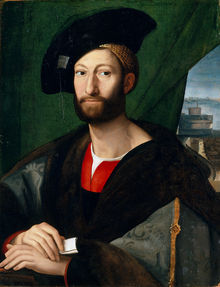Giuliano di Lorenzo de 'Medici

Giuliano di Lorenzo de 'Medici (born March 12, 1479 in Florence , † March 17, 1516 in Fiesole ) was the third-born son of Lorenzo il Magnifico after Piero di Lorenzo de' Medici and Giovanni de 'Medici . From 1515 he was Duke of Nemours .
Life
Childhood and youth
Giuliano was born in the aftermath of the Pazzi conspiracy and in the days of the war that followed. The choice of his name commemorated his uncle Giuliano di Piero de 'Medici who was murdered on April 26, 1478 . A literary work by his father, the "Rappresentazione di San Giovanni e Paolo", settled in the environment of the youth: On February 17, 1491 Giuliano de 'Medici was accepted into the Compagnia del Vangelista , one of the fraternities of the hometown.
Medici period in exile (1494–1512)
Giuliano's older brother Piero was after the death of his father Lorenzo from April 1492 to November 1494 the head of the family and thus the most important politician in Florence. Giuliano was among the brothers when the November 9th 1494 coup led to the expulsion of the Medici and their flight towards Bologna. The trigger was the threat to Florence in view of the approaching army of Charles VIII of France , who came south from Lombardy to attack the Kingdom of Naples. The Florence opposition had come to an early agreement with the French, whose side took up the side and opposed the Medici support for the Aragonese of Naples.
In the following years Giuliano was involved several times in attempts to encircle Florence and enable the return. After the Italian march of Louis XII. of France , after the conquest of Lombardy in 1499/1500 and after the establishment of a temporary rule over Naples in 1501/02, he was involved in diplomatic attempts. In the spring of 1502 he was present at the court of France and tried to direct French favor by promising future contributions to the Medici and to enable a return to Florence.
The ducal court of Urbino deserves special mention for Giuliano's time in exile at the turn of the year 1506/07. As a semi-literary figure he is also mentioned and involved in “ Il Libro del cortegiano ” by Baldassare Castiglione . The court of Urbino was also the birthplace of the bastard Ippolito de 'Medici in March 1511. The mother was supposedly Pacifica Brandano.
Brother of Pope Leo X (1513-1516)
When the conquest of Lombardy by Louis XII. of 1499/1500 and the presence of French power in Italy under the power of the Holy League led by Pope Julius II collapsed in 1511 in the summer of 1512, the paths of the Medici were paved: After the Florentines had so far been protected by French protection against attempts to return had secured, the opportunity had now come to overthrow the republic. After Piero Soderini's deposition and flight , Giuliano was the first representative of his family to return to his hometown on September 1 of that year.
When the brother Giovanni took the chair of Peter in March 1513 and figured as Pope Leo X , Giuliano, as the closest relative of the Pope , was specially chosen to lead the fortunes of Florence. He was the subject of dynasty politics from January 1515, when he married Philiberta of Savoy . Since Philiberta was an aunt of Francis I of France , one could even speculate that the French would get in touch in view of their return hopes and war plans. Such a conjunction would fit into Leo X's fluctuating policy of alliance between the defense and surrender of Italy. In any case, in this context Giuliano acquired the Duchy of Nemours, which Jean d'Armagnac had ruled before him. Nonetheless, Giuliano was physically frail. Since the second half of 1515 at the latest, his nephew Lorenzo di Piero de 'Medici effectively represented him in political and military tasks.
In keeping with his role, Giuliano was the original dedicatee of the work The Prince by Niccolò Machiavelli at the turn of the year 1513/14 . However, his role as a bearer of hope of all kinds ended after about eight months of infirmity with his death in the Abbey of Fiesole on March 17th, 1516. The burial in Florence took place on March 19th.
Legacy and aftermath
After Giuliano's death, the nephew Lorenzo finally followed in the footsteps of the dynastic hopes and plans. The fact that the Medici resided in Urbino during their time in exile, but in the summer of 1516, a few months after Giuliano's death, took action against the duchy and incorporated it into their family, was considered an act of disloyalty. Giuliano had later aftereffects in his family, insofar as the bastard Ippolito - his only descendant - temporarily ruled Florence.
Giuliano's portrait of Raphael in Rome shows him in front of a curtain behind which the Castel Sant'Angelo can be seen. A study for the painting hangs in the Metropolitan Museum . Giuliano's tomb in the Medici Chapel of the Basilica di San Lorenzo di Firenze is adorned with the night and day by Michelangelo , along with a statue of Giuliano, also by Michelangelo.
swell
- Emmanuella Lugnani Scarano (Ed.): Opere di Francesco Guicciardini. Storia d'Italia, Turin 1981 (especially vol. 2).
Web links
Remarks
- ↑ See Emilio Bigi (ed.): Scritti scelti di Lorenzo de 'Medici , Turin 1965, p. 551.
| personal data | |
|---|---|
| SURNAME | Medici, Giuliano di Lorenzo de ' |
| BRIEF DESCRIPTION | Duke of Nemours; Lord of Florence |
| DATE OF BIRTH | March 12, 1479 |
| PLACE OF BIRTH | Florence |
| DATE OF DEATH | March 17, 1516 |
| Place of death | Fiesole |
